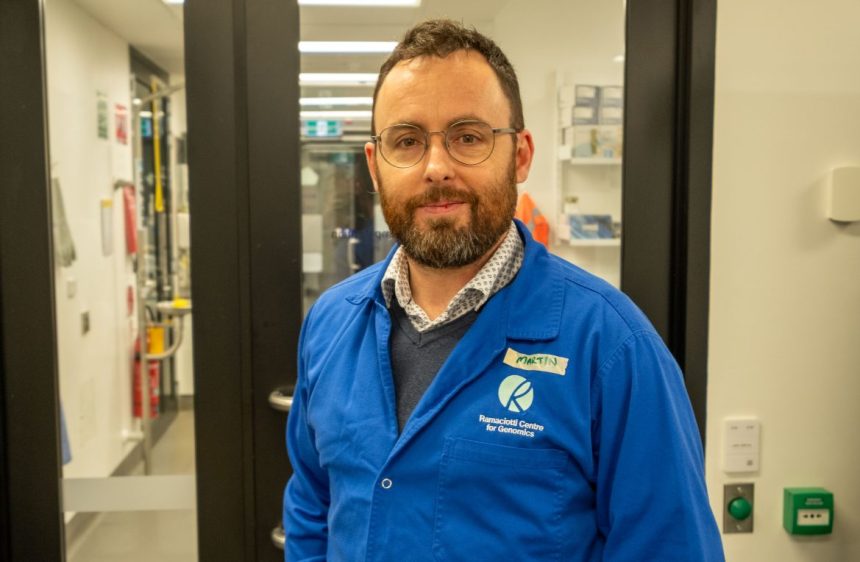We mapped the human genome decades ago, but most of it is still a black box. Now, UNSW scientists have developed a tool to peer inside and what they find could reshape how we think about disease.
Your genome is the genetic map of you, and we understand almost none of it.
Our handle on the bits of the genome that tell the body how to do things (“make eyes blue”, “build heart tissue”, “give this person sickle cell anaemia”) is okay, but there are vast areas of the genome that don’t appear to do anything.
Scientists long assumed this was just “junk” DNA, leftovers from the billions of years it took us to evolve from primordial slop into the complex life we know today.
But it turns out we just didn’t know what to look for, nor how to look for it.
Now, new tools developed at UNSW Sydney in collaboration with researchers from the University of Montreal and McGill University are helping us understand just how important the dark genome really is.
Understanding that, scientists hope, will offer new avenues for drug discovery, and transform how we think about disease and even life itself.
Seeing in the dark
Your genome is broken up into protein-coding genes (around 2%), and the rest.
Proteins are the little machines that do the actual work of running an organism; protein-coding genes are the instructions for those proteins.
The other 98% doesn’t build proteins, it doesn’t follow the same rules, and it’s much harder to understand.
It contains “long non-coding RNAs”, the stuff that was long dismissed as junk.
“We’re trying to decode the logic circuitry of the human genome – the hidden rules that tell our DNA how to build and run a human being,” says study author Associate Professor Martin Smith, from the UNSW School of Biotechnology & Biomolecular Sciences.
It’s a tough job, but a crucial one because studies show that the roots of many diseases, including heart disease, cancer, and some psychiatric disorders, lie outside the well-understood, protein-coding regions of the genome.
Non-protein coding genes have key regulatory roles, turning certain genes on and off or altering their shape.
Do any of that at the wrong time, and things start to break down.
“We think that these RNAs act like software, orchestrating the protein ‘hardware’ into a functioning symphony,” says A/Prof. Smith.
Not junk, after all.
You are not a banana
You might have heard that you share 60% of your DNA with a banana.
It’s not strictly speaking true, unfortunately, but there is a germ of truth there.
Humans and bananas (and everything else) all evolved from the same soup of bacteria and single-celled organisms about four billion years ago, and some of our DNA has been conserved over that time because it performs fundamental functions in our cells.
Studies have shown that about 10% of the human genome shows obvious conservation, but the rest is harder to pin down.
“We suspect that the remaining approximatey 90% of the genome harbours many conserved RNA structures that are invisible to traditional approaches – hidden regulatory elements camouflaged in the genome,” says A/Prof. Smith.
Which is where the UNSW-developed AI – a tool called ECSFinder – comes in. It has been detailed in a recent paper in the journal Nucleic Acids Research, opens in a new window.
A/Prof. Smith and his team trained the program on known RNA structures to detect secrets hidden in the genome.
The program outperformed other available tools and is now ready to be unleashed on the entire genome.
“We expect to uncover hundreds of thousands of new RNA structures, adding a new dimension to our understanding of the genome,” says A/Prof. Smith.
Truly personalised health care
The holy grail of medicine right now is personalised therapy, treatments designed specifically for your individual illness.
One day, it’s hoped, clinicians will be able to take a sample of your cancer’s DNA, map its genome, then design ultra-specific drugs around its weaknesses, all within a few weeks.
And if the secrets of all gene-driven illnesses are hidden somewhere in the dark genome, learning how to read it is imperative.
For A/Prof. Smith, the real promise of ECSFinder lies not just in decoding the dark genome, but in bringing it into the clinic.
“Because RNA structures can be targeted by drugs, they present an exciting new frontier for therapies.”
Source: University of New South Wales
Published on September 3, 2025


